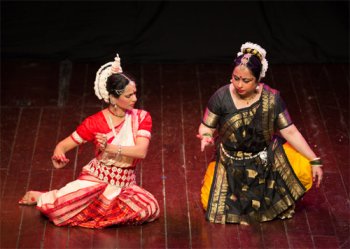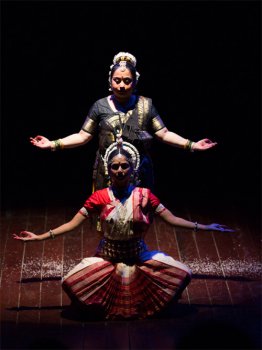
|   |

|   |
Samvaada - Nandini Bajekal e-mail: bajekaln@gmail.com November 21, 2012 On the dusky, rainy evening of Nov 4th, I was eagerly driving to Substation (Singapore) to watch a performance called ‘Samvaada’ (Dialogue) between two distinguished artistes showcasing two distinct Indian classical dance styles – Dr. Siri Rama performing in the Kuchipudi style and Jyoti Unni performing in the Odissi style. Maneuvering through the wet roads, I could not but help experience another interesting ‘Samvaada’ between the two elements of nature – earth and water. The mood was set! What more could one ask for….?  Expectantly I entered the cosy, intimate hall after being ushered in enthusiastically by the organizers. All auspicious events begin with an invocation to Lord Ganesha. ‘Samvaada’ began with a beautiful rendition in praise of Ganesha in his dancing form. ‘Tandava Nritya Kari Gajanana’ a Marathi composition in raga Hamsadhwani set in Talamalika. Tandava is usually associated with Lord Shiva and is a vigorous dance which displays the cosmic cycles of creation, preservation and dissolution. It was truly delightful to see Ganesha known for his generous paunch, large ears and tusks dancing the tandava. While Dr. Siri Rama intricately displayed the sways of Ganesha’s trunk to eclectic foot work, Jyoti Unni’s Ganesha’s grace characterized by various stances filled the hall with the exuberance of Tandava. Next, both dancers did solo performances, displaying the techniques and nuances of each dance form. First, Jyoti Unni presented ‘Pallavi’ in raga Mukhari set to the beat of Ektaal. The dance evolved gracefully, along with the music from a slow rhythmic tempo to a rhapsodic crescendo. It was pleasing to trace the dancer’s lilting eye, body and foot movements.  Siri Rama danced to a composition from a traditional repertoire of her Guru C R Acharyulu. A sort of a three piece medley, starting with a tantalizing Shiva Tandava in raga Shivaranjani set in Talamalika, the robust, masculine aspect of Shiva’s cosmic dance blended brilliantly with Parvati’s graceful, cajoling lasya which she is supposed to have danced in response to the tandava. Siri then delicately weaved in the episode of young Markandeya who overcomes death by the grace of Lord Shiva bringing out Markandeya’s ardent devotion and faith towards Lord Shiva with ease. She aptly danced with vigour and fervor in the ‘Samudra Manthan’ (churning of the ocean), where Shiva drinks the poison which emerged upon churning the ocean by the gods and the demons, for the amrit (divine nectar). The foot tapping Tarana in raga Mohana set to adi taal, saw both the dancers performing together, perfectly blending their precise and distinct foot work to the rhythm, laya (pace) and bol of the Tarana (lyric which uses mnemonic syllables to express the rhythmic patterns of the percussion instrument). Needless to say, the music added spice to the flavour of the dance. No Kuchipudi performance is complete without the Tarangam, in which the dancer places her feet on the rim of a brass plate and with swift, elegant footwork to the rhythm of the percussions, mesmerizes the audience. Siri performed the Tarangam, while Jyoti Unni played the cymbals with the typical Odissi torso movement and ‘bhedas’ (head, neck and eye movements) to perfection. The dialogue moved on to the celebrated epic Ramayana. Various scenes enfolding the story of the epic were presented with precision and ease bringing the stage alive. The first half of the performance was set to music in the Kuchipudi style while the second half was in the Odissi style. The Samvaada climaxed to an unusual and thought provoking, modern twist to the Ramayana. It was a dialogue between the two significant female characters of Ramayana – Sita (portrayed by Jyoti Unni) and Surpanakha (portrayed by Siri Rama). Sita, after being banished by Rama, lives in the forest with her twin sons. Surprised to see her sons with exotic flowers, she finds out from them about the lady who grows them in her garden. When she approaches the lady, she is taken aback to see Surpanakha. After relating their predicament to each other, Surpanakha reveals the story of her transformation, from hatred and revenge, self pity followed by the positive awareness that was brought about by the asymmetries in nature. She begins to love herself and her surroundings. Abhinaya explored by the dancers to enhance the intricacies of the situation and emotions of the characters worked to their favour. The body postures and mudras were used by both the dancers brilliantly. All in all, Samvaada was an engaging piece of work. It was a great opportunity for the audience to watch and appreciate the technicalities, structure and nuances of the two great classical styles of dance juxtaposed on a common platform. |